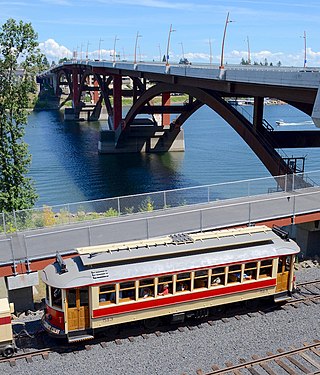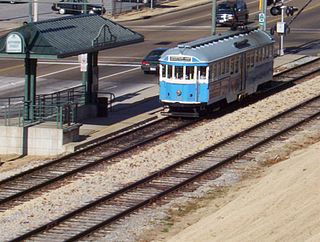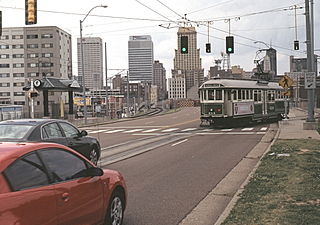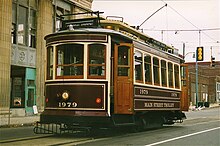
Streetcars in New Orleans have been an integral part of the city's public transportation network since the first half of the 19th century. The longest of New Orleans' streetcar lines, the St. Charles Avenue line, is the oldest continuously operating street railway system in the world. Today, the streetcars are operated by the New Orleans Regional Transit Authority (RTA).

The Willamette Shore Trolley is a heritage railroad or heritage streetcar that operates along the west bank of the Willamette River between Portland and Lake Oswego in the U.S. state of Oregon. The right-of-way is owned by a group of local-area governments who purchased it in 1988 in order to preserve it for potential future rail transit. Streetcar excursion service began operating on a trial basis in 1987, lasting about three months, and regular operation on a long-term basis began in 1990. The Oregon Electric Railway Historical Society has been the line's operator since 1995.

A Birney or Birney Safety Car is a type of streetcar that was manufactured in the United States in the 1910s and 1920s. The design was small and light and was intended to be an economical means of providing frequent service at a lower infrastructure and labor cost than conventional streetcars. Production of Birney cars lasted from 1915 until 1930, and more than 6,000 of the original, single-truck version were built. Several different manufacturers built Birney cars. The design was "the first mass-produced standard streetcar " in North America.

The TECO Line Streetcar is a heritage streetcar transit line in Tampa, Florida, run by the Hillsborough Area Regional Transportation Authority (HART), owned by the city of Tampa, and managed by Tampa Historic Streetcar, Inc. It connects Downtown and Channelside to the historic Ybor City district. There is also an "In-Town" trolley-replica bus system that connects Downtown, Channelside, and Harbour Island.

The Memphis Area Transit Authority (MATA) is the public transportation provider for Memphis, Tennessee. It is one of the largest transit providers in the state of Tennessee; MATA transports customers in the City of Memphis and parts of Shelby County on fixed-route buses, paratransit vehicles, demand-responsive service, and the MATA Trolley system. The system is managed by a seven-member policy board appointed by the mayor and approved by the Memphis City Council. In 2022, the system had a ridership of 3,204,000.
The Charlotte Area Transit System (CATS) is the agency responsible for public transportation in the Charlotte metropolitan area. CATS operates bus and rail transit services in Mecklenburg County and surrounding areas. Established in 1999, CATS' bus and rail operations carry about 320,000 riders on an average week. CATS is governed by the Metropolitan Transit Commission and is operated as a department of the City of Charlotte. In 2022, the system had a ridership of 10,759,300, or about 32,900 per weekday as of the fourth quarter of 2022.

Downtown Memphis, Tennessee is the central business district of Memphis, Tennessee and is located along the Mississippi River between Interstate 40 to the north, Interstate 55 to the south and I-240 to the east, where it abuts Midtown Memphis.

Old Pueblo Trolley is a non-profit, educational corporation based in Tucson, in the U.S. state of Arizona, that is dedicated to the preservation of Arizona's mass transit history. The name also commonly refers to the heritage streetcar line which OPT began operating in 1993, on which service is currently indefinitely suspended. OPT consists of three divisions that each fill a specific role in preserving the state's mass transit history. The divisions are the Street Railway Division, Motor Bus Division and the Museum Division.

The Metro Streetcar, formerly known as the River Rail Streetcar, is a two line heritage streetcar system operating in Little Rock and North Little Rock, Arkansas. It has operated since November 1, 2004. Most recently expanded in 2007, the streetcar now operates over 3.4-mile (5.5 km) of track in a figure-eight loop pattern. The Metro Streetcar is operated by Rock Region Metro. In 2022, the system had a ridership of.

The Charlotte Trolley was a heritage streetcar that operated in Charlotte in the U.S. state of North Carolina. The line ran along the former Norfolk Southern right of way between Tremont Avenue in the Historic South End in a northerly direction to its terminus at 9th Street Uptown. It ran on tracks mostly shared with the LYNX Blue Line.

The McKinney Avenue Transit Authority (MATA), a non-profit organization, operates the M-Line Trolley in Dallas, Texas. In operation since 1989, it is an example of a heritage streetcar running historic cars. The M-Line Trolley operates 7 days per week, 365 days per year. Since 2002, the M-Line Trolley is free to the public, thanks to donations and a joint operating subsidy received from Dallas Area Rapid Transit (DART) and the Uptown Improvement District. The main stretch of the line runs along McKinney Avenue in Uptown between West Village and Klyde Warren Park / Dallas Arts District. The M-Line Trolley connects to the DART light rail system at CityPlace/Uptown on the northern end and St. Paul on the southern end.

The Fort Smith Trolley Museum is a streetcar and railroad museum in Fort Smith, in the U.S. state of Arkansas, which includes an operating heritage streetcar line. The museum opened in 1985, and operation of its streetcar line began in 1991. Four vehicles in its collection, a streetcar and three steam locomotives, are listed on the National Register of Historic Places (NRHP). The now approximately three-quarters-mile-long (1.2 km) streetcar line also passes four NRHP-listed sites, including the Fort Smith National Historic Site, the Fort Smith National Cemetery, the West Garrison Avenue Historic District and the 1907 Atkinson-Williams Warehouse Building, which now houses the Fort Smith Museum of History.

Streetcars or trolley(car)s were once the chief mode of public transit in hundreds of North American cities and towns. Most of the original urban streetcar systems were either dismantled in the mid-20th century or converted to other modes of operation, such as light rail. Today, only Toronto still operates a streetcar network essentially unchanged in layout and mode of operation.

The Galveston Island Trolley is a heritage streetcar network in Galveston, Texas, United States. As of late 2006, the total network length was 6.8 miles (10.9 km) with 22 stations. The Galveston Island Trolley is operated by Island Transit. The rail system reopened in 2021, after having been out of service for 13 years following severe damage caused by Hurricane Ike in 2008. Subsequent to the 2008 closure, the Federal Emergency Management Agency (FEMA) and the Federal Transit Administration agreed to fund repairs. In January 2017, a contract was approved to restore three of the trolleys at a cost of $3.8 million. At that time, the trolleys were expected to be ready to return to service in 2018, but the date was later postponed to 2019 and later to 2021. By November 2020, two reconditioned trolleys had returned to Galveston. The line reopened for service in October 2021, limited to three days a week for now.

Light rail in the United States is a mode of rail-based transport, usually urban in nature. When compared to heavy rail systems like commuter rail or rapid transit (subway), light rail systems are typically designed to carry fewer passengers and are capable of operating in mixed traffic or on routes that are not entirely grade-separated. Systems typically take one of four forms: the "first-generation" legacy systems, the "second-generation" modern light rail systems, streetcars, and hybrid rail systems. All of the systems use similar technologies, and some systems blur the lines between the different forms.
The Gomaco Trolley Company is a manufacturer of vintage-style streetcars, located in Ida Grove, Iowa, United States. The company has supplied replica-vintage streetcars to several transit systems in the US, and has also restored and rebuilt authentic vintage streetcars for some systems.

The Main Street Line is a line of the Memphis Area Transit Authority trolley system. It began operations in 1993, becoming the first streetcar line to operate in Memphis since 1947. It runs for about 2 mi (3.2 km) along Main Street, with 14 stops in Downtown Memphis. The Main Street Line is concurrent with the Riverfront Loop for almost all of its length.

The Riverfront Loop is a line of the Memphis Area Transit Authority trolley system. It began operation in 1997, as the second line in the system. It runs for 4.1 mi (6.6 km) through downtown Memphis and along the Mississippi riverfront, with 18 stops along the way. It is the longest of the system's three lines, though it concurrent with the Main Street Line for about half of its length. Part of the line offers panoramic views of the Mississippi River from atop to the Chickasaw Bluffs.

The Madison Avenue Line is a line of the Memphis Area Transit Authority trolley system. The trolley line began operating in 2004, and cost $56 million to build. It consists of 2.2 mi (3.5 km) of double track along Madison Avenue with six stops stretching into Midtown Memphis. The line was built to connect the Main Street system to the Medical District just east of Downtown Memphis. Trolley service has been suspended since April 2014, after two trolley cars caught fire within a span of six months. Buses have been serving the line since then, but MATA plans to restore trolley operation to the line eventually.

The Riverfront Streetcar Line is a historic streetcar line in New Orleans, Louisiana. It is operated by the New Orleans Regional Transit Authority (RTA). It was built along the east bank of the Mississippi River, in an area with many amenities catering to tourists. It opened August 14, 1988, making it the first new streetcar route in New Orleans in 62 years. The line runs 2 miles (3.2 km) from Julia Street at the upper end of the New Orleans Convention Center to the downriver (far) end of the French Quarter at the foot of Esplanade Avenue. Unlike the other three lines, it travels on an exclusive right-of-way, along the river levee beside New Orleans Belt Railway tracks, making it more akin to a light rail line. The line was regauged in 1997 from standard gauge to broad gauge. Officially, the Riverfront Line is designated Route 2 and is designated with a blue color on most RTA publications.




























